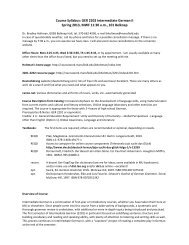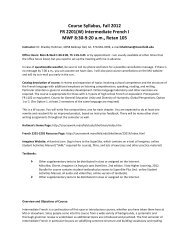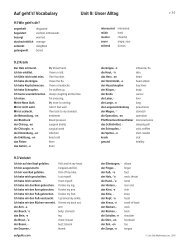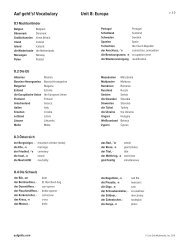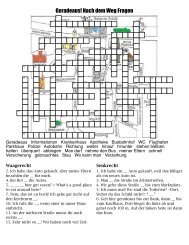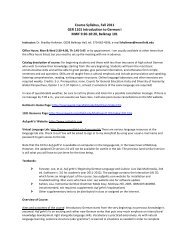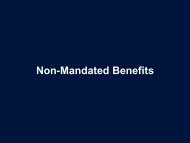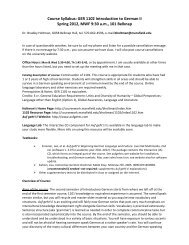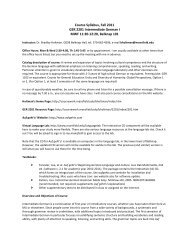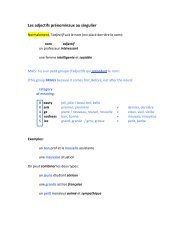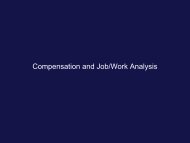Selection Interview
Selection Interview
Selection Interview
You also want an ePaper? Increase the reach of your titles
YUMPU automatically turns print PDFs into web optimized ePapers that Google loves.
<strong>Selection</strong>
Goals<br />
‣ Use some type of “test” in the present<br />
to predict future job performance<br />
‣ To “discriminate” among applicants
Steps in<br />
Development<br />
of a New<br />
<strong>Selection</strong><br />
Program<br />
Job Analysis<br />
Identify Relevant Tasks,<br />
Duties, and Dimensions of<br />
Job Performance<br />
Identify Knowledge, Skills, Abilities,<br />
and Other Characteristics (KSAOs)<br />
Necessary for Job Performance<br />
Develop or Identify Existing<br />
<strong>Selection</strong> Test(s) to Assess<br />
Applicant Behaviors & KSAO Levels<br />
Examine Reliability,<br />
Validity, and Utility of<br />
<strong>Selection</strong> Test(s)<br />
If OK<br />
If Not OK<br />
Put <strong>Selection</strong> Test(s) into<br />
Operational Use
<strong>Selection</strong>: <strong>Interview</strong>s
Variables That May Influence <strong>Interview</strong> Outcomes<br />
Applicant<br />
Age, race, sex, etc.<br />
Physical appearance<br />
Educational & work<br />
background<br />
Job interests & career plans<br />
Attitude, intelligence,<br />
motivation, etc.<br />
Experience & training as an<br />
interviewee<br />
Perceptions of interviewer,<br />
job, company, etc.<br />
Verbal & nonverbal behavior<br />
Situation<br />
Political, legal, &<br />
economic forces in<br />
marketplace &<br />
organization<br />
Role of interview in<br />
selection system<br />
<strong>Selection</strong> ratio<br />
Physical setting:<br />
Comfort, privacy, number<br />
of interviewers<br />
<strong>Interview</strong> structure<br />
Employment<br />
<strong>Interview</strong><br />
<strong>Interview</strong>er<br />
Age, race, sex, etc.<br />
Physical appearance<br />
Attitude, intelligence,<br />
motivation, etc.<br />
Experience & training as an<br />
interviewer<br />
Perceptions of job<br />
requirements<br />
Prior knowledge of applicant<br />
Goals for interview<br />
Verbal & nonverbal behavior<br />
(Arvey & Campion, 1982)<br />
<strong>Interview</strong> Outcome
Recommendations from Research<br />
• Narrow scope - restrict interview content to most job-relevant duties,<br />
KSAOs, or competencies<br />
• Carefully review use of pre-interview data (Concern with “knowledge of<br />
predictor” bias!)<br />
• Adopt semi-structured format<br />
• Use only job-related questions<br />
• Use multiple questions for each attribute being assessed<br />
• Develop and use a formal scoring format allowing separate evaluation<br />
of each attribute<br />
• Train the interviewers<br />
• Where possible, use an interview panel<br />
(Adapted from Gatewood & Feild, 1987)
Questions: A Few Guidelines<br />
• Prepare: Plan questions prior to interview<br />
• Is the question relevant to the interview’s objective<br />
• Can the response be easily recorded and scored<br />
• As phrased, is the question likely to be understood<br />
• Avoid illegal questions!<br />
(Stewart & Cash, 2000)
Job Content <strong>Interview</strong> Strategy<br />
1. Job analysis (uses Combination Job Analysis Method or C-JAM)<br />
- Identify and rate tasks/KSAOs<br />
- Link KSAOs to critical tasks<br />
- Choose KSAOs important for the selection stage<br />
2. Develop a “selection plan”<br />
3. Generate critical incidents for interview KSAOs<br />
4. Incidents, KSAOs, tasks interview questions<br />
5. Incidents, KSAOs, tasks behavioral scoring guide<br />
6. Record applicant responses (take notes!)<br />
7. Rate response to each item using scoring guide<br />
(Adapted from Feild & Gatewood, 1989)



